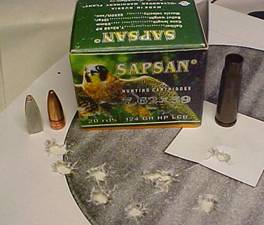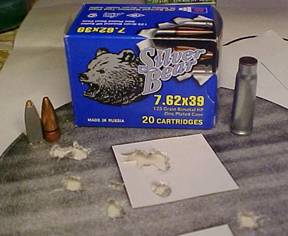|
What
about all that inexpensive Russian Ammo? By
Adam
Celaya
|
||||
|
To
anyone who owns Russian rifles, the glut of inexpensive Russian ammo has
been a real windfall. Think
about it; at less than $3 per box of rifle ammo there is no American
made ammo that even comes close economically speaking.
And we are not talking about bad ammo here.
Most of the imports feature hollow point bullets, water-sealed
primers and bullets, all loaded to Soviet military specs.
Granted, the steel Berdan primed cases cannot be reloaded, but at
$2.34 a box, who in their right mind would want waste their time
reloading the stuff? The last year has seen several new contenders on the market. Every week when I walk into my favorite gun store I am greeted by yet another new brand at an even better price than the previous sale. I have made a point of picking up a box or two every payday just to stockpile the stuff. It may sound terribly survivalist to keep a few thousand rounds on hand but from an economical standpoint it makes total sense: these prices cannot last forever. Eventually, one of two things will happen;
And with more than half a dozen different brands of 7.62x39 out there itís easy to stockpile a hodgepodge of ammo. This leads to the question ďIs there any difference between the different brands? Is one better than the others? For this test I used five Russian-made products and one domestic (Winchester) as a basis for comparison. While my first instinct was to chronograph the rounds followed by expansion/penetration tests, I in fact did not speed test the rounds. The reason is simple enough; Why? Can you say that anyone has ever questioned the lethality of the AK47? Seriously, if a 123 grain bullet strikes you in the torso at any speed higher than 1200fps, you are out of there. Yes, I have heard of those who took multiple torso hits from such cartridges and still drove on. However, these tales are few and far between. In each the victim is usually relegated to a defensive status, rarely are they in any position to continue in an offensive manner. What I did test was how well these rounds
survive against the elements. I
have long been curious to know just how worthwhile the primer and bullet
sealant are on the Russian ammo. To
find out I submerged test samples in water for 24 hours then fired them.
The surprising thing was not that the Russian ammo fired
perfectly (nobody knows wet weather like the Russians) but that the
unsealed The
next step of testing was to pull the bullets and inspect the
manufacturing processes. Normally
I would go straight to test firing but with ammo in this price range I
had a desire to see how well made they were.
Results were interesting enough.
Three of the manufacturers (JSC, SUE, & Saspan) all used
nearly identical bullets while all of the Russian ammo appeared to use
the same extruded powder. All
were Berdan primed, all were made from non-reloadable steel casings
(except for Which
brings us to the corrosion tests. The
six casings were subjected to 3 days in standing water before being
allowed to sit out and dry. Surprisingly
enough, all brands performed admirably except for Silver Bear.
Apparently the silvery zinc coating is water soluble since it
came off in large patches and corroded enough to have rendered the ammo
unusable. The other Russian
brands resisted virtually all corrosion due to their enamel coating.
I was most surprised that The
final and most critical test was downrange accuracy.
While it is good to have ammo that resists the elements, it is
all for naught if it shoots a big sloppy group.
Due to the tactical doctrine of the 7.62 round, these rounds were
tested in a hot gun. Using a
dozen or so spare rounds to warm up the barrel first, no attempt was
made to cool the weapons between shots.
We arenít testing a deer rifle here! Right
off I was surprised at the results.
I had totally expected In
summary, each of the rounds here had minor issues.
SUE shot the best but had a low point of impact compared to the
other five.
|
__________________________________________
SUE shot the best (2.47 inch group), passed the submersion tests, aced the corrosion tests, and is wonderfully priced. However, it shoots to a much lower point of aim than the others tested here making it less interchangeable than the brands tested.
_____________________________________
Surprisingly
enough,
_____________________________________
Saspan is a newcomer on the American market. With a 3.42 inch group it came in third of six. Priced to move, Saspan passed all submersion/corrosion tests while shooting respectable groups. Like most of the Russian ammo tested here it sports a lacquered case with sealed primers and bullets.
Wolf is the original bargain ammo that started it all. It was also the only ammo tested here that sported a boat-tail bullet. With acceptable accuracy (3.49 inch group) it passed all of the water tests, is widely available, and inexpensive. Try the link at the bottom of the page for Wolf Ammo from Cheaper than dirt (who also sells a drum magazine for the Ak47 varients)
Silver
bear shot a 3.95 inch group but its zinc-coated casings made it the only
brand tested here that failed the corrosion tests.
It may look like stainless steel---but
it ainít!
________________________________________
|
|||









